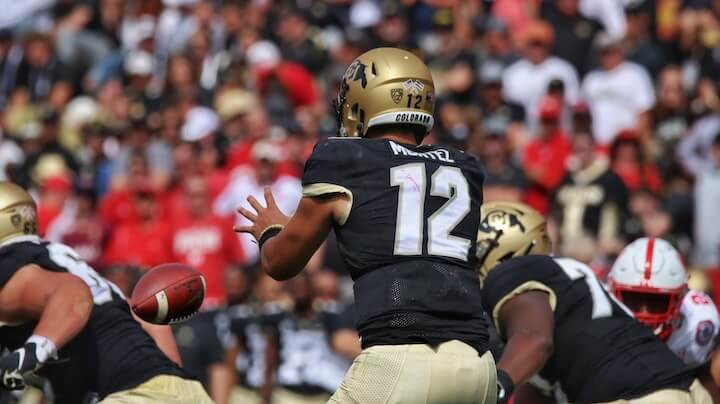Are you curious about the meaning behind the term “hike” in football? This article provides a comprehensive explanation of what a hike is, its purpose, variations, and how it impacts the game, ensuring you’re well-informed on football terminology. Explore CAUHOI2025.UK.COM for more football insights.
1. The Hike Defined: Initiating the Play
In American football, the “hike” refers to the action of the center snapping the ball to the quarterback (QB) to begin a play. Think of it as the official starting gun for each offensive sequence. This act serves two critical functions: it physically moves the ball from the center to the QB and acts as a verbal cue to the rest of the offense.
1.1. The Physical Act: The Snap
The hike physically describes the action of the center passing the ball between their legs to the quarterback. This is known as the snap and is the first movement of the football in a play.
There are two primary methods for the center to hike the ball to the quarterback:
- Under Center: The quarterback positions their hands directly under the center’s backside, and the center snaps the ball directly into the quarterback’s hands.
- Shotgun Formation: The quarterback lines up several yards behind the center, requiring the center to snap the ball with enough force and accuracy for it to reach the quarterback in the air.
Whether the quarterback is under center or in shotgun formation, the action of snapping the ball is still referred to as the hike.
1.2. The Verbal Cue: A Synchronized Start
The term “hike” also functions as a verbal signal to the offensive players, indicating that the play is about to commence. This is crucial for timing and coordination, giving the offense a potential advantage over the defense.
2. The Importance of the Snap Count
One of the primary advantages the offense has is knowing the snap count. The snap count refers to the specific timing of when the ball will be snapped. This knowledge allows the offensive players to synchronize their movements and gain a slight edge over the defense.
2.1. Gaining a Head Start
Knowing the exact moment the snap will occur allows offensive players to anticipate the play and react faster than the defensive players. This timing is crucial for effective blocking, route running, and overall offensive execution.
2.2. The Risk of Offsides
If the defense anticipates the snap count and jumps across the line of scrimmage before the ball is snapped, they are penalized for being offsides. This penalty gives the offense free yardage and can disrupt the defense’s strategy.
3. Variations on the Verbal Cue
While “hike” is the most common term, there’s no official rule mandating its use. The quarterback can use other words or even a silent count to initiate the play.
3.1. “Hut” as an Alternative
Some teams may use the term “hut” instead of “hike.” This is simply a variation, and the meaning remains the same. The important thing is consistency.
3.2. The Coach’s Choice
The coach ultimately decides what word the quarterback uses to signal the snap. This can be “hike,” “hut,” or any other agreed-upon term. However, it’s vital that the quarterback uses the same word consistently to avoid confusion.
3.3. Avoiding Confusion
Inconsistency in the verbal cue can lead to miscommunication and timing errors, which can disrupt the entire play. Therefore, it’s crucial for the quarterback to use the same word every time.
 center-is-preparing-to-hike-the-ball-to-the-quarterback-during-a-football-game
center-is-preparing-to-hike-the-ball-to-the-quarterback-during-a-football-game
4. The Snap Count and Its Variations
Sometimes, you might hear a quarterback call “hike” or “hut” without the center snapping the ball. This is often a strategic move to keep the defense guessing.
4.1. Playing “On One”
Most plays are run “on one,” meaning the center snaps the ball immediately after the quarterback says “hike” or “hut.” This is the most common snap count.
4.2. Varying the Snap Count
The offense can also run plays “on two,” “on three,” or even higher numbers. This means the center will snap the ball on the second, third, or subsequent utterance of the verbal cue. Varying the snap count can disrupt the defense’s timing and prevent them from anticipating the snap.
4.3. Keeping the Defense Off Balance
If the defense starts to anticipate the snap count, they might try to time their movements to coincide with the quarterback’s verbal cue. By varying the snap count, the offense can keep the defense guessing and prevent them from gaining an advantage.
4.4. The Huddle Communication
The quarterback communicates the play and snap count to the rest of the offense in the huddle. This ensures that everyone is on the same page and knows when the play will begin.
4.5. Inducing Offsides Penalties
By varying the snap count, the offense can try to bait the defense into jumping offsides. If a defensive player anticipates the snap and crosses the line of scrimmage before the ball is snapped, they are penalized, giving the offense a free advantage.
5. The Silent Count: An Alternative Method
Although less common, teams can utilize a silent count. This involves the quarterback using a visual cue, such as a head nod or hand gesture, instead of a verbal command to signal the snap.
5.1. When to Use a Silent Count
Silent counts are often used in noisy environments, such as when playing in an opposing team’s stadium with a loud crowd. The noise can make it difficult for the offensive players to hear the quarterback’s verbal cues.
5.2. The Element of Surprise
The silent count can also be used to catch the defense off guard. By not using a verbal cue, the offense can snap the ball at an unexpected moment, potentially disrupting the defense’s timing.
6. Examples of “Hike” in Football Terminology
Here are a few examples of how “hike” is used in football-related contexts:
- “The quarterback yelled ‘hike,’ and the center snapped the ball perfectly.”
- “The team was penalized because the defensive end jumped offsides before the hike.”
- “The coach told the quarterback to vary the snap count to keep the defense guessing.”
- “In a shotgun formation, the center needs to make sure to hike the ball to the quarterback accurately.”
7. Advanced Strategies Related to the Hike
Beyond the basics, the “hike” is integrated into more complex offensive strategies.
7.1. Quick Snaps and Tempo
Some offenses employ a no-huddle strategy, aiming to snap the ball as quickly as possible to keep the defense from substituting or setting up properly. The hike becomes even more critical in these situations.
7.2. Play-Action Fakes
The hike is a critical component of play-action fakes, where the quarterback pretends to hand the ball off before passing. The timing of the hike and the subsequent fake must be precise to deceive the defense.
7.3. Audibles at the Line
Quarterbacks often make audibles, or changes to the play, at the line of scrimmage after reading the defense. The “hike” then initiates the adjusted play.
8. The Center’s Role in the Hike
The center is a vital position on the offensive line, and their ability to consistently deliver accurate and timely snaps is essential for the success of the offense.
8.1. Consistent Snapping Mechanics
A good center practices their snapping mechanics to ensure that they can consistently deliver accurate snaps to the quarterback, regardless of the situation.
8.2. Reading the Defense
The center also needs to be able to read the defense and make adjustments to their blocking assignments accordingly. This requires a high level of football intelligence and communication with the other offensive linemen.
8.3. Protecting the Quarterback
In addition to snapping the ball, the center is also responsible for protecting the quarterback from defensive pressure. This requires them to be strong, athletic, and technically sound.
9. Common Mistakes During the Hike
Even at the professional level, mistakes can happen during the hike.
9.1. Bad Snaps
A bad snap can disrupt the timing of the play and even result in a turnover. This can happen if the center doesn’t grip the ball properly, or if they get disrupted by the defense.
9.2. False Starts
A false start occurs when an offensive player moves before the ball is snapped. This can happen if a player anticipates the snap count or if they get confused about the play call.
9.3. Delay of Game
A delay of game penalty occurs when the offense fails to snap the ball before the play clock expires. This can happen if the quarterback is taking too long to read the defense or if the offense is disorganized.
10. Key Takeaways
- The “hike” is the action of the center snapping the ball to the quarterback to begin a play.
- It serves as both a physical action and a verbal cue for the offense.
- The snap count is the specific timing of when the ball will be snapped.
- The offense can vary the snap count to keep the defense guessing.
- Teams can also use a silent count, where the quarterback uses a visual cue to signal the snap.
- The center is a vital position on the offensive line, and their ability to consistently deliver accurate and timely snaps is essential for the success of the offense.
11. Frequently Asked Questions (FAQ)
Q1: What does “hike” mean in football?
A1: “Hike” signifies the start of a play, where the center snaps the ball to the quarterback.
Q2: Can the quarterback use a different word than “hike?”
A2: Yes, alternatives like “hut” can be used, but consistency is key.
Q3: What is a snap count?
A3: The snap count determines when the center will snap the ball after the quarterback’s verbal cue.
Q4: Why do offenses vary the snap count?
A4: To keep the defense off balance and prevent them from anticipating the snap.
Q5: What is a silent count?
A5: A silent count uses visual cues instead of verbal commands to signal the snap.
Q6: What is the center’s role in the hike?
A6: The center must deliver accurate and timely snaps while also protecting the quarterback.
Q7: What is a bad snap?
A7: A bad snap is an inaccurate snap that can disrupt the play.
Q8: What is a false start?
A8: A false start occurs when an offensive player moves before the ball is snapped.
Q9: What is a delay of game?
A9: A delay of game penalty occurs when the offense fails to snap the ball before the play clock expires.
Q10: Why is the hike important in football?
A10: The hike is essential for starting each play with coordination, timing, and potential strategic advantages.
12. Conclusion: Mastering the Fundamentals
Understanding the “hike” in football provides valuable insight into the intricacies of the game. It’s more than just a word; it’s the starting point of every offensive play and a key element of strategy.
Do you have more questions about football terminology or strategy? Visit CauHoi2025.UK.COM for detailed answers and expert insights. If you need further clarification or personalized advice, our team is here to assist you. Contact us today and enhance your understanding of the game! Equitable Life Building, 120 Broadway, New York, NY 10004, USA. Call us at +1 (800) 555-0199.
By mastering the fundamentals like the “hike,” fans and players alike can appreciate the complexity and excitement of American football.

